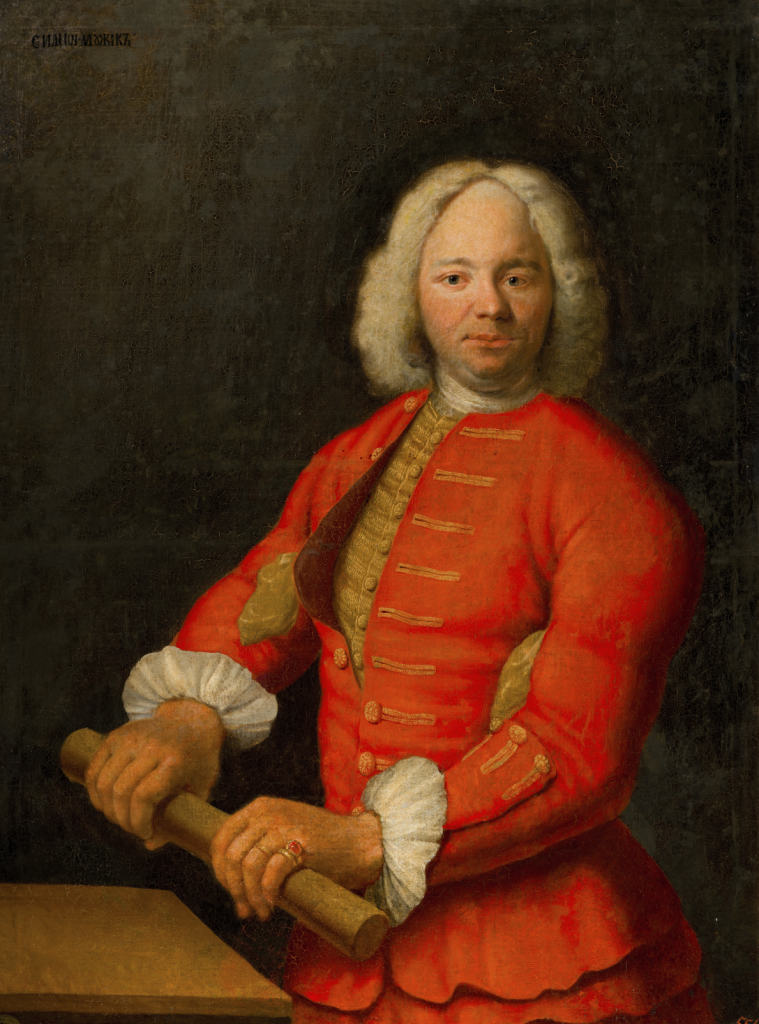


Буржуа Николай (Буржоа, Боржуа, Bourgeois) (168?–1724). Француз, великан и силач (рост 2 м 27 см). Был нанят Петром I в 1717 во время заграничного путешествия в городе Кале и привезен в Петербург, где служил гайдуком царя. По приказанию Петра его «для опыта» женили на высокого роста «чухонке» для получения рослого потомства. После смерти Буржуа его скелет и внутренние органы были переданы в Кунсткамеру, где экспонируются и поныне. Тогда же, в 1724, К.-Б. Растрелли было заказано изготовить подвижную фигуру-манекен великана из дерева, обтянутую его кожей. Этот экспонат вплоть до конца XVIII века находился в Кунсткамере. Петр I. Время и окружение. СПб, 2015. С. 124.
Традиционно считается работой Г. Гзеля. Предположение об авторстве впервые высказано в каталоге портретной выставки 1870 года. В 1724 году после смерти Буржуа К.-Б. Растрелли изготовил подвижную фигуру-манекен великана из дерева, обтянутую его кожей (до конца ХVIII века находилась в Кунсткамере). Портрет, возможно, написан именно с этой фигуры, а не с натуры. Тематически «сильной мужик» хорошо вписывается в «Преображенскую серию» — портреты участников «Всешутейшего собора» создавались и при Екатерине I. Петр I. Время и окружение. СПб, 2015. С. 107.
Живописец, рисовальщик. Занимался портретной, монументально-декоративной, бытовой живописью, писал образа. В 1690–1695 учился в Вене у антверпенского живописца А. Схоньяна (А. Schoonjans). С 1704 жил в Антверпене, потом в Амстердаме, где в 1715 женился на художнице Марии Доротее Генриетте Граф. Приехал в Россию по приглашению Петра I, которого встретил в Амстердаме, в 1717 (в других источниках называется 1716 и 1718). Был управляющим картинной галереей в Петергофе. Расписывал плафоны Летнего дворца и грот в Летнем саду.
С 1726 преподавал рисунок и живопись в АН. Работал для Кунсткамеры, делал проекты иллюминаций, композиции для триумфальных ворот. Написал «картину в купол» и девять образов для Петропавловского собора. В 1729 писал тринадцать полотен для лютеранской церкви Св. Петра на Невском проспекте — поколенные изображения апостолов и евангелистов, а также «Распятие». В 1731 принимал участие в оформлении Триумфальных ворот к коронации Анны Иоанновны. В 1728–1731 исполнил десять картин для Петропавловского собора на сюжеты Страстей Христовых. В 1735 представил проект росписей для Сенатского зала Двенадцати коллегий, отвергнутый комиссией в составе М. Г. Земцова и А. Матвеева. В 1738–1739 Я. Штелином при помощи Г. Гзеля были составлены описи живописных коллекций петергофских дворцов Монплезир, Эрмитаж, Марли. Много лет работал при Кунсткамере. В связи с тем, что двое сыновей тоже занимались рисованием и живописью, художника называли «Отец Кселль». Его учениками были Ф. Черкасов, А. Греков, М. Некрасов, А. Малиновкин, И. Нестеров, П. Пагин, А. Дедешин, И. Шерешперов.

Nicholas Bourgeois (168?–1724). Frenchman, giant and strongman (his height was 2 m 27 cm). Peter the Great hired him during his trip abroad in the town of Calais and brought him to St Petersburg where Bourgeois would serve as a footman of the tsar. Peter made him couple with tall Finnish women to see if their children would be as tall as they were. After his death the giant’s skeleton and internal organs were sent over to the Kunstkamera where they are still exhibited. It was also in 1724 that Carlo Bartolomeo Rastrelli was ordered to construct a mobile wooden leather-covered model of the giant’s body. The item was kept in the Kunstkamera until the end of the 18th century.
Traditionally, the portrait is considered to be created by Georg Gsell. The hypothesis first appears in the catalogue of a portrait exhibition of 1870. In 1724, after Bourgeois’ death, Carlo Bartolomeo Rastrelli created a mobile, wooden, leather-covered model of Bourgeois’ gigantic figure. It is possible that the portrait was painted from this model, not from life. Thematically the “strong man” fits well in the Preobrazhensky Series; these were paintings of members of the Drunken Synod whose portraits were created during the reign of Catherine I.
Painter, graphic artist. He painted portraits, murals, genre paintings, and icons. In 1690–1695 he studied in Vienna under the Antwerp painter А. Schoonjans. In 1704 he moved to Antwerp, and subsequently, to Amsterdam, where he married the artist Dorothea Maria Henrietta Graff in 1715. In 1717 (other sources mention 1716 and 1718) he came to Russia at the invitation of Peter the Great, whom he met in Amsterdam. He was in charge of the Picture Gallery in Peterhof. He painted the plafonds at the Summer Palace, and the rockwork in the Summer Garden. In 1726 he taught drawing and painting in the Academy of Sciences. He also worked at the Kunstkamera, made projects of illuminations, and designed compositions for the triumphal gates. He painted the picture for the dome of the Peter and Paul Cathedral, as well as nine icons for the interior. In 1729 he created thirteen paintings for the Lutheran Church of Saint Peter on Nevsky Prospect: the knee-high images of the Apostles and Gospel writers, and an image of the Crucifixion. In 1731 he took part in decorating the Triumphal Gates for the coronation of Anna Ioannovna. In 1728–1731 he made ten paintings for the Peter and Paul Cathedral based on the Stations of the Cross and the Passion of Christ. In 1735 he presented a project of murals for the Senate Hall of the Twelve Colleges, but the commission, consisting of Mikhail Zemtsov and Andrei Matveyev, rejected it. In 1738–1739 Georg Gsell helped Jacob von Stäehlin to complete inventories of the painting collections of Peterhof Palaces: Monplaisir, Hermitage, and Marly. For many years he worked at the Kunstkamera. His two sons were painters as well, so the artist was known as “Father Gsell.” Among his students were such artists as Fyodor Cherkasov, A. Grekov, Mikhail Nekrasov, Alexei Malinovkin, Ivan Nesterov, Pyotr Pagin, A. Dedeshin, and Ivan Shereshperov.



